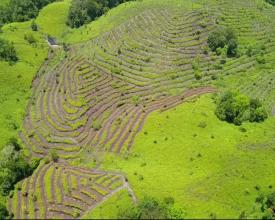Life - Restauración ecológica mediante asociaciones

Biodiversity Sri Lanka, en colaboración con el Departamento Forestal de Sri Lanka, la UICN Sri Lanka y socios seleccionados del sector privado, emprendió un proyecto piloto para establecer una línea de base de biodiversidad en una zona de 10 ha de selva tropical degradada, que fue talada para el cultivo y posteriormente abandonada, lo que provocó la colonización de la misma por la especie pionera de helecho Dicranopteris linearis, situada en el Bosque de Conservación de Kanneliya. La intención era restaurar esta zona utilizando los principios de la ecología de restauración, para mejorar sus funciones ecológicas, la calidad del hábitat, la diversidad de especies y su capacidad de proporcionar biodiversidad y servicios ecosistémicos que se aproximen al bosque húmedo de tierras bajas del que formaba parte anteriormente, antes de que se convirtiera a su estado actual.El proyecto pretendía desarrollar un Sistema de Acumulación de Créditos de Biodiversidad para Sri Lanka utilizando los conocimientos obtenidos, con el objetivo de asignar un valor unitario a la biodiversidad mejorada y a los servicios ecosistémicos.
Impactos
Los socios que participen en el proyecto piloto serán reconocidos como pioneros en este novedoso sistema y serán las primeras empresas del sector privado que obtengan créditos de biodiversidad de las actividades de restauración, que se registrarán en un "Bio-registro" y podrán utilizarse en una fase posterior para la compensación gestionada de su huella de biodiversidad. El proyecto también supervisa los avances con respecto a los cambios en la diversidad y composición de las especies en la zona restaurada y los cambios mensurables en los servicios ecosistémicos, como la mejora de la calidad y cantidad del suelo y el agua dentro del lugar restaurado.El proyecto también ha proporcionado amplias oportunidades para programas de participación del personal. Los socios contribuirán a la formulación de un libro blanco para su consideración por los organismos estatales en la formulación de una política nacional bien pensada para la compensación de la biodiversidad - permitiendo así a los propietarios de proyectos, con incentivos para gestionar la tierra con fines de conservación por primera vez en el país. También es un medio de mejorar los medios de subsistencia de las comunidades circundantes a través de beneficios indirectos como la mejora de los servicios ecosistémicos del proyecto y la participación directa en términos de empleo en las diversas funciones que exige el proyecto.
